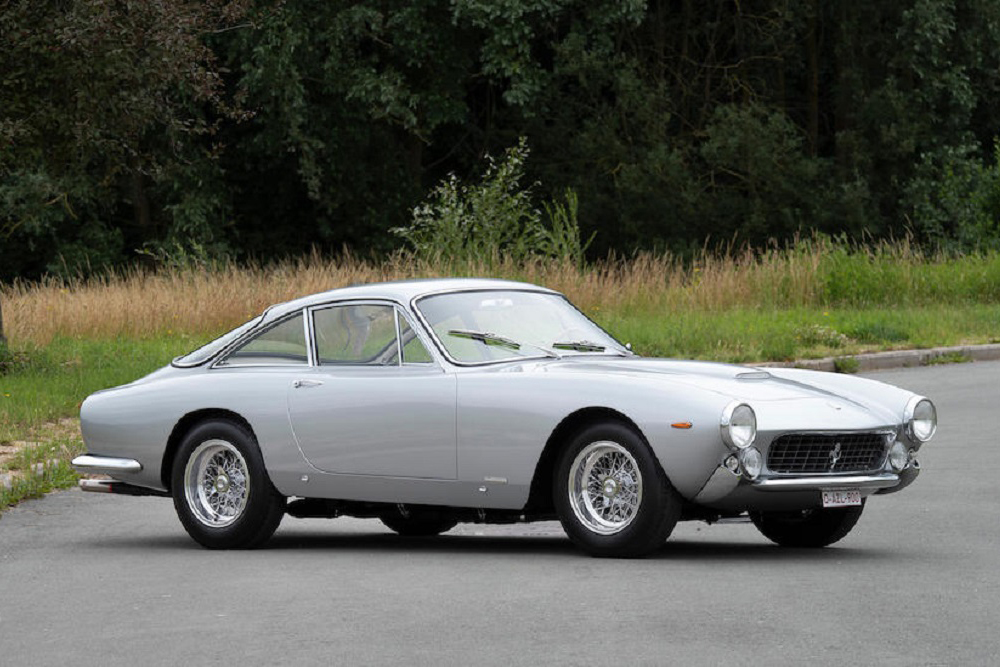“This new luxury Berlinetta has been developed from the car which allowed so many gentlemen to enjoy sports car performance. It boasts those characteristics valued by enthusiasts while also possessing the comfort required by the ladies.” – Ferrari’s brochure for the 250 GT Lusso.

Chassis no. 5017 GT
•Long term ownership by Ferrari importer Charles Pozzi
•One of 350 produced
•Delivered new to France
•Matching numbers example
•Concours standard restoration
Arguably the most beautiful product ever to carry the Maranello marque’s prancing horse emblem, the 250 GT Lusso debuted at the Paris Salon in October 1962. Styled by Pininfarina and built by Scaglietti, the Lusso (Luxury) combined racetrack looks with new standards of passenger comfort. Beautifully proportioned, it blended a low-slung nose, reminiscent of that of the SWB Berlinetta, with a sculpted Kamm tail by means of some of the most exquisite lines yet seen on an automobile. Slim pillars and wide expanses of glass not only enhanced the car’s outward appearance but made for excellent visibility and a pleasantly light and airy interior. “The design of the body was at once elegant and exciting and no other road Ferrari before or since has earned the same degree of enduring admiration for its aesthetics,” declared Road & Track.
After Pininfarina had completed the prototype Lusso, production was entrusted to Carrozzeria Scaglietti, a smaller concern that specialised in building low-volume models for Ferrari. In total, 350 Lussos (including one prototype each from Pininfarina and Scaglietti) would be completed over the next two years, with deliveries of the production model commencing early in 1963. “Its proportions approach perfection, and the execution is faultless,” enthused Car & Driver. “It makes for Grand Touring in the grandest possible manner…”
The Lusso’s immediate antecedent had been the 250 GT Berlinetta SWB. Introduced at the 1959 Paris Salon, the latter was a true dual-purpose car, arguably more capable than any Ferrari before or since of coping equally well with the conflicting demands of racetrack and highway. The ‘SWB’ (Short Wheelbase) designation arose from a chassis that, at 2,400mm, was 200mm shorter than the standard 250 GT’s. Specifications could be varied to suit individual customers’ requirements for either road or track, models supplied for competition use having lightweight aluminium-alloy bodies, while the lusso road version came with a fully-trimmed interior and softer springing.
However, Ferrari’s policy of building a single, dual-purpose race/road model did not survive long into the 1960s, the diverging requirements of the two markets necessitating greater specialisation in the form of the competition-only 250 GTO and the touring 250 GT Lusso. Built on a short-wheelbase chassis similar to that of the 250 GT SWB and 250 GTO, the Lusso was powered by Gioacchino Colombo’s light and compact 3.0-litre V12. Ferrari’s first in-house power plant, the supremely versatile Colombo V12 had debuted in 1947 as a 1.5-litre unit and would enjoy a remarkably long production life, finally bowing out in 4.9-litre quad-cam form in 1988. Breathing through three twin-choke Weber carburettors, this all-aluminium, two-cam, Tipo 168 unit produced 240bhp at 7,500rpm as installed in the Lusso, giving it a top speed of 150mph (240km/h) and a useful 0-100mph (0-160km/h) acceleration time of 19.5 seconds. Power was transmitted to the road via a conventional four-speed gearbox, and the power train was housed in Ferrari’s familiar steel spaceframe chassis with oval main tubes. Suspension was conventional for the time: independent at the front by means of ‘A’ arms and coil springs, with a semi-elliptically sprung live axle at the rear.
The result was not only one of the best looking Ferraris ever made, but also, courtesy of its competizione antecedents, one of the most rewarding to drive. “Driving a Ferrari smoothly is always easy; the Lusso is no exception,” proclaimed R&T. “The gearshift moves like the proverbial stick in a bowl of whipped cream, and the smooth clutch combines with the 12-cylinder engine’s buttery delivery of torque to make it nearly impossible… to stall the engine when moving off from rest.” R&T found that the Lusso’s steering was lighter than one would expect and remarked on its smooth, predictable, and forgiving handling. They were also much impressed by the powerful servo-assisted four-wheel disc brakes.

An important milestone in the Maranello marque’s history, the 250 GT Lusso was the last of the long-running 250 series that had done so much to cement Ferrari’s commercial success, and a most fitting finale to this remarkable family of Ferrari road cars.
The 109th of the 350 Lussos made, left-hand drive chassis number ‘5017’ was delivered at the end of 1963 to Mr Ferdinand de Valenciennes by Franco-Britannic Automobiles, the Ferrari importer in France at the time, and registered as ‘269 DX 59’. Around 1970 the car passed into the hands of a Mr Domet and was reregistered as ‘1 RA 60’, and some ten years later was bought by Charles Pozzi, who had become the Ferrari importer for France in 1967. Mr Pozzi kept the Lusso (registered ‘7406 TP 92’) from circa 1980 until 2004. Before then, in 2002, his daughter Christine had driven the Ferrari in the Tour Auto (number ‘224’).
In 2004 the Lusso was sold to a Mr Rouer of Paris and registered ‘863 PTP 75′. Mr Rouer competed with it in the Tour Auto in 2012 (number ’42’). Passing to a Mr Hibert of Brussels in 2014, the Ferrari remained unused until 2018 when it was acquired by the present owner, who commissioned a total restoration. Documented in full, the rebuild was carried out by the best specialists in Modena, with no limit on the budget: Bacchelli & Villa for the bodywork; Garuti for the mechanicals; Bertachi for the electrics; and Luppi for the interior trim. Ferrari certified ‘5017’ at the completion of the restoration in December 2019. A rare opportunity to acquire a car – seldom offered for sale – that is not only one of the most beautiful and exclusive Ferraris ever made, but also one of the most enjoyable to drive and own: the 250 GT Lusso.
Pozzi owned it from around 1980-2004 so when he was already Ferrari importer since 1967. His daughter did the Tour Auto in it in 2002.
Report by bonhams.com










